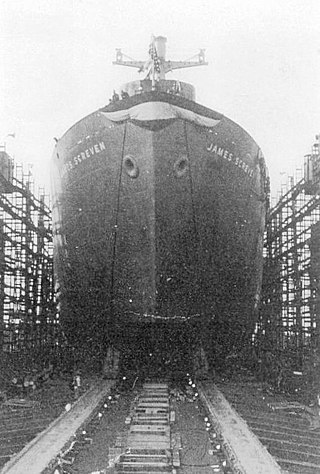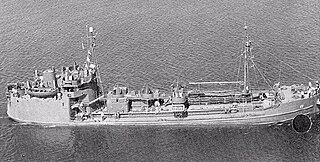
The USS Albireo (AK-90) was a Crater-class cargo ship in the service of the US Navy in World War II and manned by a US Coast Guard crew. She was the only ship of the Navy to have borne this name. She is named after Albireo, a star in the constellation of Cygnus.

USS Camel (IX-133), an Armadillo-class tanker, was the second ship of the United States Navy to be named for the camel, a ruminant found in Asia and Africa. She was launched 31 October 1943 as William H. Carruth by California Shipbuilding Corporation, in Wilmington, California, under a Maritime Commission contract sponsored by Mrs. J. Low, was acquired by the Navy 22 November 1943, and commissioned the same day.
USS Armadillo (IX-111), the lead ship of her class of tanker was the only ship of the United States Navy to be named for the armadillo, an insect-eating mammal which has an armorlike shell encasing its back and head.
The second USS Whippet (IX-129), an Armadillo-class tanker designated an unclassified miscellaneous vessel, was the second ship of the United States Navy to be named for the whippet. Her keel was laid down on 31 October 1943 at New Orleans, Louisiana, by the Delta Shipbuilding Company under a Maritime Commission contract. She was launched on 15 December 1943 sponsored by Mrs. Will Camp Sealy, delivered to the Navy on 13 January 1944, and commissioned on 14 January 1944.

USS Patuxent (AO-44) was a Kennebec-class oiler in the United States Navy during World War II. She was the second U.S. Navy ship named for the Patuxent River in Maryland.

USS Millicoma (AO-73) was a United States Navy fleet oiler which served in the Pacific Theatre during World War II, winning eight battle stars for her dangerous work. Post-war she was recommissioned and was placed under the control of the MSTS with a civilian crew until finally assigned for disposal in 1987.

USS Schuylkill (AO-76), originally named the SS Louisburg, was a Type T2-SE-A1 Suamico-class fleet oiler of the United States Navy.

USS Cahaba (AO-82) was an Escambia-class replenishment oiler acquired by the United States Navy for use during World War II. She had the dangerous but necessary task of providing fuel to vessels in combat and non-combat areas primarily in the Pacific Ocean. For her brave efforts, she received eight battle stars during the war.
USS Oklawaha (AO-84) was a Escambia-class replenishment oiler acquired by the United States Navy for use during World War II. She had the dangerous but necessary task of providing water to smaller vessels not fitted with water-makers in combat and non-combat areas.

USS Alkes (AK-110) was a Crater-class cargo ship commissioned by the US Navy for service in World War II, named after Alkes, a star in the Crater constellation. She was responsible for delivering troops, goods and equipment to locations in the war zone.

USS Shaula (AK-118) was a Crater-class cargo ship, converted from a Liberty Ship, commissioned by the US Navy for service in World War II. She was first named after James Screven, an American general during the American Revolutionary War. She was renamed and commissioned after Shaula, the second-brightest star system in the constellation of Scorpius. She was responsible for delivering troops, goods and equipment to locations in the war zone.

USS Beaverhead (AK-161) was an Alamosa-class cargo ship commissioned by the U.S. Navy for service in World War II. She was responsible for delivering troops, goods and equipment to locations in the war zone.

USS Mettawee (AOG-17) was a Mettawee-class T1 tanker type gasoline tanker acquired by the U.S. Navy for the dangerous task of transporting gasoline to warships in the fleet, and to remote Navy stations.
USS Pasquotank (AOG-18) was a Mettawee-class T1 tanker type gasoline tanker acquired by the U.S. Navy for the dangerous task of transporting gasoline to warships in the fleet, and to remote Navy stations.
USS Seekonk (AOG-20) was a Mettawee-class gasoline tanker acquired by the U.S. Navy for the dangerous task of transporting gasoline to warships in the fleet, and to remote Navy stations.
USS Ammonusuc (AOG-23) was a Mettawee-class gasoline tanker acquired by the U.S. Navy for the dangerous task of transporting gasoline to warships in the fleet, and to remote Navy stations.
USS Kalamazoo (AOG-30) was a T1-M-A2 Mettawee-class gasoline tanker acquired by the U.S. Navy for the dangerous task of transporting gasoline to warships in the fleet, and to remote Navy stations.
USS Narraguagas (AOG-32) was a Mettawee-class gasoline tanker acquired by the U.S. Navy for the dangerous task of transporting gasoline to warships in the fleet, and to remote Navy stations.
USS Ochlockonee (AOG-33) was a Mettawee-class gasoline tanker acquired by the U.S. Navy for the dangerous task of transporting gasoline to warships in the fleet, and to remote Navy stations.

USS Chimariko (ATF-154) was an Abnaki class Fleet Ocean Tug of the United States Navy and the first to be named Chimariko after the Native American tribe in California.










